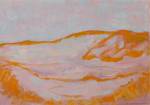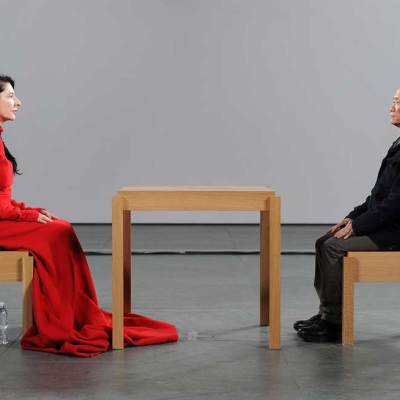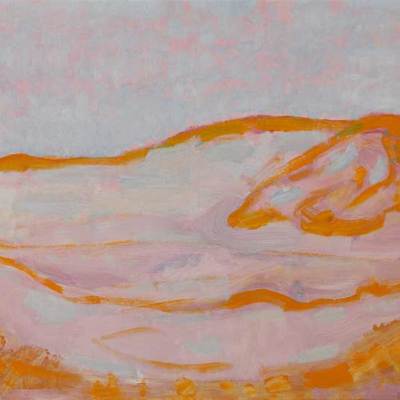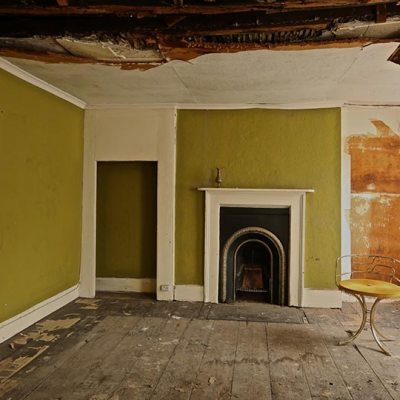Farmhouse with Wash on the Line (c. 1897), Piet Mondrian © 2014 Mondrian/Holtzman Trust c/o HCR International USA

Brown. This is the predominant colour in the first room of Turner Contemporary’s current exhibition, ‘Mondrian and Colour’ (until 21 September). Born from a muddy palette, the artist’s early provincial landscapes are a far cry from the gridded urban vibrancy of Broadway Boogie Woogie. Staged to commemorate the 70th anniversary of Mondrian’s death, the exhibition, which is a companion piece to Tate Liverpool’s ‘Mondrian and his Studios’, traces the artist’s arrival in the 1920s at a primary coloured purism. The path to abstraction was a colourful one.
Rooted in a Dutch academic tradition, Mondrian’s early realist experiments depict trees, washing lines and farm buildings. But the strict earthy tones used here soon give way to a more daring use of colour in landscapes such as The Red Cloud (1907). Recalling Van Gogh and the Fauves, the red of an ordinarily white cloud complicates the painting’s naturalism and suggests a moment of transition. Where dark trees were once crowded into the canvas, now the landscape has been opened up.
This sense of expansion is also true of Mondrian’s dune sketches, which are flatter, the horizon more pronounced. The title of Dune Sketch in Bright Stripes (1909) reveals its subject, but this is a work that is pared down, the sand only hinted at in swirling bands of yellow. This contrasts with Mondrian’s interest around this time in verticals; mills, churches and lighthouses that seem to herald his later black lines. The Red Mill (1911), although clearly that, is all surface. The striking use of red and blue in this work (and in the pointillist-inspired portraits on show) relates not only to Mondrian’s interest in Goethe’s colour theories, but also more profoundly to his enthusiasm for theosophy, which fuelled his desire for a more spiritual form of pictorial representation.
Composition in Oval with Colour Planes II (1914), Piet Mondrian © 2014 Mondrian/Holtzman Trust c/o HCR International

With so many visual styles in play – Expressionism, Fauvism, Pointillism – the exhibition suggests that these early years presented a long, frustrating search for a visual language – one capable of mystic illumination. Drawn to Paris in 1912 Mondrian also explored Cubism, seeing in it an even bolder escape from a realist mode of representation. Composition In Oval with Colour Planes II (1914) shows the artist breaking down his motifs into scaffolds of black lines, and blocks of colour. The muted pink, turquoise and ochre hues that expand over the canvas have echoes of his early landscapes but are clearly on the way to becoming the red, blue and yellow that mark Mondrian’s modernism.
Composition with Large Red Plane, Yellow, Black, Grey and Blue (1921), Piet Mondrian © 2014 Mondrian/Holtzman Trust c/o HCR International USA

What this show tells us about Mondrian and colour is that he had to take it away. But in this subtraction, the colours are no less vivid. His classic Neoplastic works, executed from the 1920s to the mid 1930s, are full of movement and variety. The black lines in Composition with Red, Blue, Black, Yellow and Grey (1921) fall short of the canvas edges while the white paint, surprisingly textured when you get up close, unapologetically nudges into grey.
I wondered how Mondrian would sit in Margate. But these Chipperfield galleries, all high ceilings and angular windows, are equally studies in both colour and space. And outside, the sea and sky expand limitlessly, subject to shifts in light. Here Mondrian’s dune paintings and seascapes seem apt, their horizon lines echoing the changing expanse outside.
‘Spencer Finch: The Skies can’t keep their secret’ (installation view at Turner Contemporary) Photo: Stephen White

Complementing the Mondrian show is a meditative display by American artist Spencer Finch, whose work reflects on Margate’s coastal site, and on the interplay between light, colour and perception. In an ongoing series, Finch captures the changes in natural light on his studio wall through faint washes of paint – recalling Mondrian’s concern with moments of transition, the captured half-lights of twilights and sunsets. But it is in his multicoloured grid of painted squares in Back to Kansas (2013) where the nod to Mondrian and 20th-century abstraction is to be found. The squares of colours are said to change as darkness grows. They make a fitting supplement to Mondrian’s shifting palette.
‘Mondrian and Colour’ is at Turner Contemporary, Margate, until 21 September.
Related Articles
First Look: ‘Mondrian and Colour’ at Turner Contemporary (Sarah Martin)





